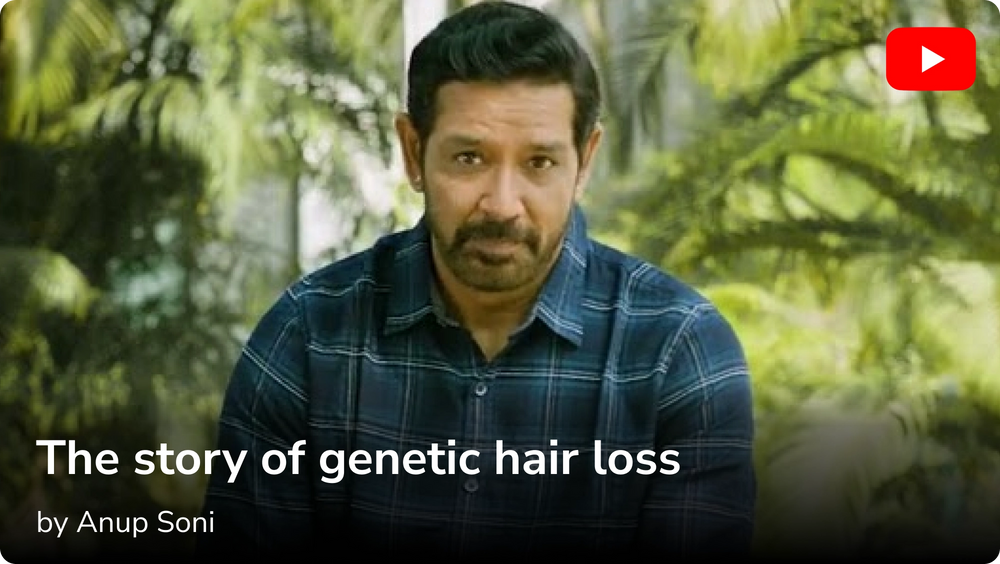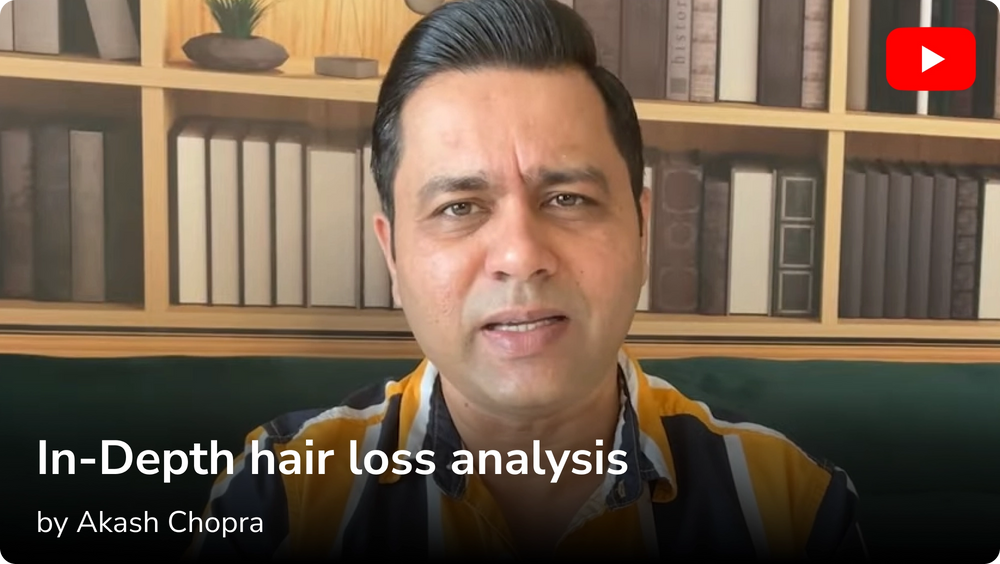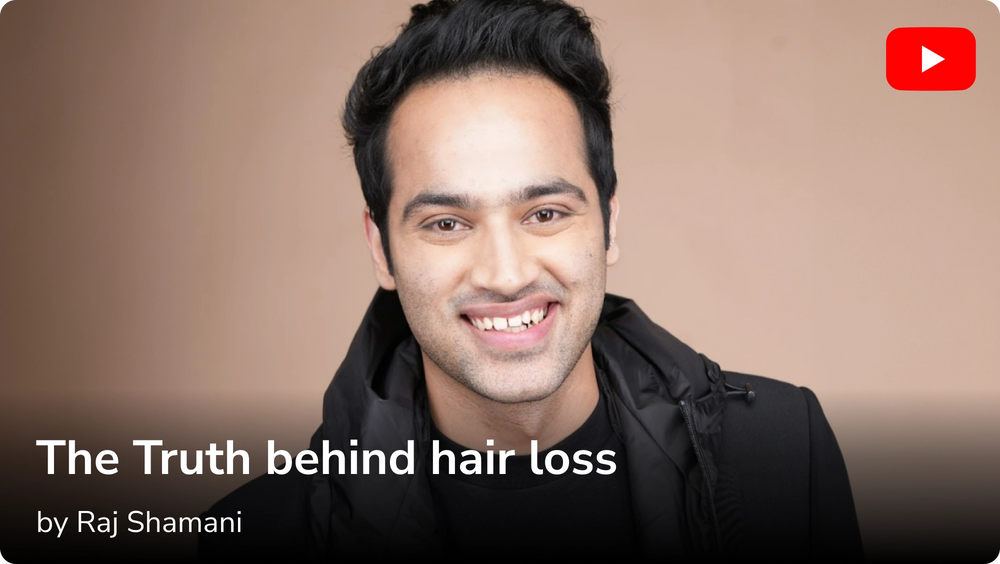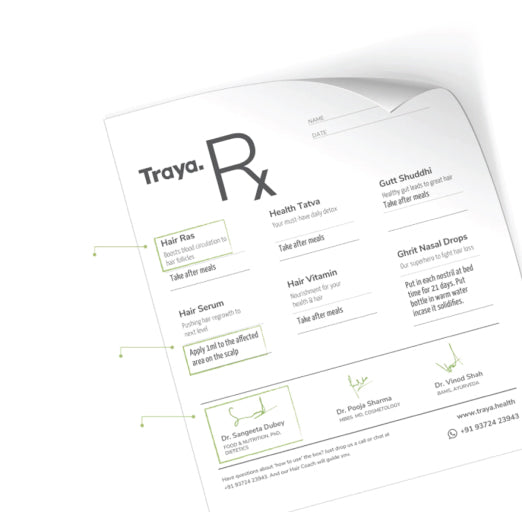Traya vs. Minoxidil & Finasteride: The Ultimate Hair Regrowth Solution
Finding the right solution for hair regrowth is a struggle! And we get that.
Many people go through a trial-and-error phase with different products, but constantly exposing your scalp to various chemicals can be exhausting, and in some cases, it may even lead to scalp irritation and long-term damage to hair follicles.
Among the most researched treatments are Minoxidil and Finasteride topical solution uses. Their effectiveness, benefits, and drawbacks have been widely studied, and many users report positive results.
At Traya, We had conducted a Clinical Study which showed us how a holistic personlized treatment gave 3X better results than just using a single formula, such as Minoxidil. Our findings stated that: Traya’s treatment has a success rate of 93%, compared to 40% for Minoxidil alone.
But are they the right treatments for you? If so, which one should you choose? And if neither seems like the right fit, what other options are available?
Stay with us as we guide you toward the best solution for your hair!
Minoxidil: How It Works, Benefits, & Side Effects
Minoxidil is a widely used solution for hair regrowth, primarily recommended for androgenetic alopecia (male and female pattern baldness). Originally developed to treat high blood pressure, it was later found to stimulate hair growth, leading to its use as a topical treatment.
How Does Minoxidil Work?
Minoxidil helps by extending the anagen (growth) phase of the hair cycle, which slows down hair loss and promotes thicker, healthier strands. It also improves blood circulation to the scalp, ensuring better nourishment for hair follicles. However, its effectiveness varies from person to person due to differences in how the body converts it into its active form.
Uses of Minoxidil
-
Male & Female Pattern Baldness: The most common use of Minoxidil is for hereditary hair loss.
-
Other Hair Loss Conditions: In some cases, it may be used off-label for other types of hair thinning, but results are less predictable.
Application & Availability
-
Available as a topical solution or foam in 2% and 5% concentrations.
-
Applied directly to the scalp twice a day for the best results.
Potential Side Effects of Minoxidil
While many users tolerate Minoxidil well, some may experience:
-
Scalp irritation (redness, itching, or dryness)
-
Increased hair shedding initially, as weaker hairs make way for new growth
-
Unwanted hair growth on the face or hands if the solution spreads beyond the scalp
-
Dizziness or heart palpitations (rare but possible, especially with oral Minoxidil)
Should You Use Minoxidil?
While Minoxidil can be effective, results vary based on individual response and the cause of hair loss. It’s best to consult a dermatologist before starting treatment to ensure it’s the right solution for your hair concerns.
Next, let’s explore Finasteride and how it compares to Minoxidil.
Also Read: Minoxidil For Hair Growth: Benefits, Side Effects, Usage
Finasteride: How It Works, Benefits, & Side Effects
Finasteride is an FDA-approved oral medication primarily used to treat male pattern baldness. It works by inhibiting the enzyme 5-alpha reductase, which converts testosterone into dihydrotestosterone (DHT), a hormone linked to hair loss.
How It Works
-
Reduces DHT levels in the scalp
-
Slows down hair thinning
-
Helps maintain existing hair and, in some cases, stimulates regrowth
Effectiveness: Finasteride is clinically proven to slow hair loss and, in some cases, promote regrowth, particularly on the crown and mid-scalp. Visible results may take 3–6 months.
Side Effects:
-
Reduced libido or sexual dysfunction (rare and often reversible)
-
Mild dizziness or headaches in some cases
-
Potential hormonal imbalance with prolonged use
Who Should Use It?
Finasteride is generally recommended for men experiencing androgenetic alopecia (male pattern baldness). It is not advised for women, especially those who are pregnant or planning pregnancy.
Also Note: A dermatologist consultation is essential before starting Finasteride to discuss dosage, potential side effects, and whether it suits your hair loss condition.
Key Differences: Minoxidil vs. Finasteride Topical Solution
Here’s a quick summary on the working of Minoxidil and Finestaride topical solution uses:
|
Minoxidil |
Finasteride |
|
|
How Do They Work? |
Increases blood flow to hair follicles, stimulating growth |
Blocks DHT, the hormone responsible for hair loss |
|
Effectiveness |
Works well for regrowing hair, especially in early-stage hair loss |
Best for preventing further hair loss, particularly in androgenetic alopecia |
|
Application |
Topical solution or foam applied to the scalp |
Oral tablet taken daily |
|
Time to See Results |
3-6 months |
3-6 months |
|
Side Effects |
Scalp irritation, shedding in the initial phase |
Potential sexual side effects, reduced DHT levels |
|
FDA Approval |
Yes, for male and female pattern baldness |
Yes, but only for male pattern baldness |
|
Best For |
Those experiencing thinning and wanting to regrow hair |
Those with progressive hair loss looking to prevent further balding |
|
Works for Women? |
Yes (2% and 5% minoxidil formulations) |
No, generally not recommended for women |
Which One Is Best for You? What Happens When Used Together?
Minoxidil is ideal for those looking to stimulate new hair growth, while Finasteride is better suited for those wanting to halt hair loss progression. If you’re experiencing early-stage hair loss, Minoxidil alone may help. However, if hair thinning has advanced, Finasteride can prevent further loss while Minoxidil promotes regrowth.
Many doctors recommend using both Minoxidil and Finestaride Topical Solution together , as they target different aspects of hair loss. Minoxidil boosts blood flow and stimulates hair follicles, while Finasteride tackles the root cause—DHT. When combined, they create a powerful hair restoration regimen, often yielding better and faster results. However, it’s important to be patient, as both treatments require months of consistent use.
But Are These Solutions Enough?
While Minoxidil and Finasteride are science-backed solutions, they don’t address other key factors like nutrition, scalp health, and internal imbalances. Hair loss isn’t just about what’s happening on the scalp—it’s influenced by gut health, stress, diet, and deficiencies. This is where a holistic approach to hair care becomes necessary, offering a long-term solution beyond just medications.
Why Minoxidil & Finasteride Alone Aren’t Enough?
Minoxidil (2%-5%) and Finasteride (0.1%-0.5%) are widely used for hair loss, but are they a long-term solution? While they work effectively:
-
Minoxidil expands blood vessels to boost circulation in hair follicles.
-
Finasteride blocks DHT, the hormone responsible for hair shrinkage.
However, relying on these alone is like treating the symptoms, not the cause. If you stop using them, hair fall often resumes because the root causes remain unaddressed.
Limitations of Minoxidil and Finasteride
-
Short-term fix – Hair loss resumes once treatment is discontinued.
-
No internal nourishment – These treatments only stimulate the scalp but don’t strengthen hair from within.
-
Shedding & side effects – Many users experience initial hair shedding, scalp irritation, or hormonal imbalances.
Hair loss isn’t just an external issue, it is influenced by nutrition, stress, gut health, and deficiencies. Without fixing these, hair loss can persist despite external treatments.
Why Traya’s Holistic Treatment is 3X More Effective Than Minoxidil Alone
Understanding why you’re losing hair is the first step to finding the right solution. Traya goes beyond surface treatments by addressing the internal causes of hair loss.
How Traya’s Doctor-Backed Hair Treatment Works
-
Pinpoints the root cause – A Free hair test is structured to analyze whether hair loss is due to stress, nutrition, genetics, or lifestyle.
-
Combines Ayurveda, Dermatology & Nutrition – Unlike standalone treatments, Traya’s approach stops hair loss at the root and promotes new growth.
-
Delivers long-term results – Instead of just regrowing hair, Traya strengthens follicles so hair stays healthy even after the treatment.
Simply put, Minoxidil and Finasteride may help, but they don’t fix why hair loss is happening. Traya provides a personalized, holistic treatment that ensures healthier, thicker hair—not just temporarily, but for life.
Want to know how Traya is able to achieve this? Here’s a table stating the various factors we take into consideration before formulating your treatment plan.
Comparison: Minoxidil & Finasteride vs. Traya Holistic Treatment
|
Minoxidil & Finasteride Alone |
Traya Holistic Treatment |
|
|
DHT Blockage (Hair Loss Prevention) |
Yes |
Yes (Finasteride + Ayurveda) |
|
Boosts Blood Circulation to Scalp |
Yes (Minoxidil) |
Yes (Minoxidil + Ayurvedic Oils) |
|
Strengthens Hair from the Inside |
No |
Yes (Herbal Supplements & Nutrition) |
|
Reduces Stress-Induced Hair Loss |
No |
Yes (Lifestyle & Herbal Stress Support) |
|
Treats Nutritional Deficiencies |
No |
Yes (Essential Vitamins & Minerals) |
|
Long-Term Hair Growth Maintenance |
No |
Yes |
|
Side Effects Risk |
Can cause dryness, irritation |
Safer & customized to your hair type |
Traya is India’s first holistic hair loss treatment that combines modern science with Ayurveda for complete hair recovery.
The 3 Pillars of Traya’s Hair Growth Treatment
1. DHT Blockage: Stops Hair Loss from the Root
Unlike Minoxidil, Traya’s treatment prevents hair loss by naturally blocking DHT.
-
Finasteride (For Men) – Reduces DHT levels by up to 70%, preventing follicle shrinkage.
-
Ayurvedic Herbs (Bhringraj, Yashtimadhu, Brahmi) – Strengthen follicles and reduce scalp inflammation.
Result: Less hair fall, stronger roots, and better regrowth.
2. Ayurvedic Supplements: Internal Nourishment for Thicker Hair
Minoxidil works externally, but Traya’s supplements strengthen hair from within.
-
Iron & Biotin – Combat hair loss due to deficiencies.
-
Shatavari & Ashwagandha – Reduce stress-induced hair fall.
-
Curcumin & Gokshura – Support scalp health and root strength.
Result: Thicker, shinier hair with long-lasting effects.
3. Scalp Care: The Missing Link in Hair Growth
Scalp issues like dandruff and oiliness can block regrowth. Traya’s regimen includes:
-
Anti-Dandruff Shampoo – Removes buildup with Ketoconazole, Aloe Vera, and Tea Tree Oil.
-
Scalp Serum – Nourishes follicles and prevents infections.
-
Herbal Cleansing Routine – Enhances absorption of Minoxidil & Ayurvedic oils.
A healthy scalp will lead to stronger hair which will give better regrowth!
How to Use Traya’s Treatment for Maximum Hair Regrowth
-
Apply Traya Hair Serum or Minoxidil – Massage gently onto the scalp twice daily.
-
Take Ayurvedic Supplements – 1-2 capsules daily to strengthen hair from within.
-
Use Traya Anti-Dandruff Shampoo – Wash 2-3 times a week to keep the scalp clean.
-
Follow a Balanced Diet – Include protein, biotin, and omega-3s for healthier, stronger hair.
These products are generally included in your customized Traya kit along with other treatments tailored to your specific hair needs. The Traya app provides step-by-step usage instructions for each product to ensure the best results.
Why Choose Traya Over Just Minoxidil?
With a 93% success rate and over 2,50,000 satisfied customers in India, Traya has helped thousands of people regrow thicker, healthier hair. Here are some of the proven facts about Traya and how it can be helpful in treating YOUR Hair Loss.
-
Clinically Proven Solution – Traya’s treatment is backed by a combination of modern science and Ayurveda, targeting hair loss from multiple angles for long-lasting regrowth.
-
Doctor-Certified & Personalized – Unlike Minoxidil, which is a one-size-fits-all solution, Traya’s treatment is customized based on your specific hair loss stage, ensuring you get the right combination of products for optimal results.
-
Natural & Safer Alternative – Minoxidil and oral Finasteride can cause side effects like scalp irritation, dryness, or hormonal imbalances. Traya’s holistic approach integrates Ayurvedic herbs and essential nutrients to strengthen hair naturally with minimal side effects.
-
Visible Hair Regrowth in 3-6 Months – Consistency is key! With regular use, Traya’s treatment helps stop hair loss and promotes new growth, delivering noticeable results in just a few months.
Traya goes beyond just external stimulation, it treats the root causes of hair loss for long-term hair health.
Real Users, Real Results: Success Stories with Traya
1. Mukund Jathar
"I'm thrilled with my hair growth progress, and it's all thanks to your guidance, Traya! You've helped me develop a hair care routine that really works. Thank you for your patience and expertise.”
2. Sai Sankar Ladi
“10 months before I was told by my Barber to try for Traya. For a moment I was quite and than thought why don't I give a try, there is nothing wrong as I already lost lot of hair. Started 1st month and saw hair fall started reducing...little excited and continued with the great guidence of Coaches....the result is Miracle at the age of 50 years...Hair density increased a lot...seeing the Hair regrowth my confidence levels have increased a lot....I feel so confort and happy while seeing my face in mirror 😍 finally I would like to say to all that have faith on Traya and surrender yourself and follow diet and other activities as advised by coaches...Many thanks to Traya, the great"
3. Arsad Shaikh
“I can see baby hair after 4 months using traya products"
Over 2.5 lakh Indians have successfully reversed hair loss with Traya and now you can do it too!
Take the Free Hair Test and let’s take a step further to fuller, and better hair.
You Can Read More At: Traya Success Stories
Conclusion
If you’re looking for a short-term solution, Minoxidil may help stimulate hair growth, and Finasteride can slow hair loss. However, these treatments alone do not address the root causes of hair thinning, such as poor scalp health, nutritional deficiencies, and stress.
Traya’s doctor-certified, science-backed treatment takes a holistic approach—blocking DHT, improving scalp health, and nourishing hair from within. This ensures long-term, sustainable hair regrowth with fewer side effects. If you want real, lasting results, Traya’s complete hair treatment is the best choice.
People Also Ask
Do Minoxidil and Finasteride Topical Solutions Work?
Yes, topical Minoxidil and Finasteride have been proven effective in treating hair loss. Minoxidil increases blood circulation to hair follicles, stimulating growth, while Finasteride blocks DHT, the hormone responsible for hair thinning. When used together, they can slow hair loss and promote regrowth, especially in cases of androgenetic alopecia (male and female pattern baldness).
Does Minoxidil Finasteride Regrow Hair?
Yes, both Minoxidil and Finasteride can help regrow hair, but their effectiveness depends on consistency and individual response. Minoxidil works by reviving dormant hair follicles, while Finasteride prevents further hair thinning. However, results take time, and visible improvement usually appears after 3-6 months of regular use.
Is It Safe to Use Minoxidil and Finasteride?
Both Minoxidil and Finasteride are FDA-approved and generally safe when used correctly. However, they may have side effects—Minoxidil can cause scalp irritation and dryness, while Finasteride may lead to hormonal changes in some users. Topical Finasteride has fewer systemic side effects than the oral version, making it a preferred choice for many. Consulting a doctor before use is recommended.
Can I Stop Minoxidil After 1 Month?
Stopping Minoxidil after just one month is not advisable, as it takes at least 3-6 months to show visible results. Discontinuing it too soon may not allow enough time for hair regrowth, and you may not see any noticeable improvements.
Will I Lose My Hair If I Stop Using Minoxidil?
Yes, stopping Minoxidil can lead to hair shedding, as the follicles that relied on it for growth may shrink again. This is why it’s recommended to continue using Minoxidil or switch to a holistic treatment that supports long-term hair health, such as Traya’s personalized regimen.
Can I Comb My Hair After Applying Minoxidil?
Yes, but it’s best to wait at least 30 minutes after application to allow Minoxidil to absorb into the scalp. Using a wide-tooth comb and gentle strokes can help prevent unnecessary hair breakage.





















